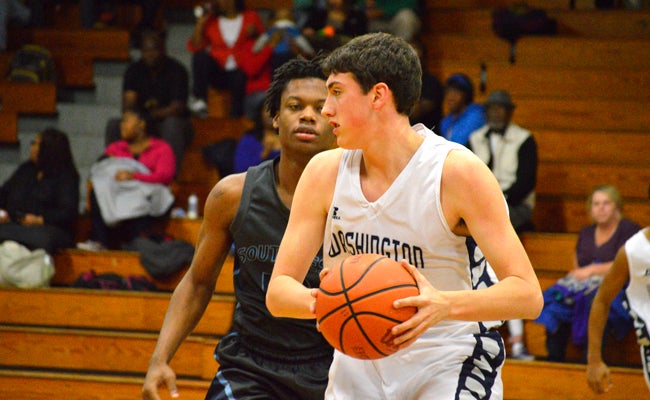STEPPING UP — My Take: NCHSAA needs to look into altering basketball format
Published 1:02 pm Friday, February 13, 2015

DAVID CUCCHIARA | DAILY NEWS
NIGHT CAP: Forward Kaleb Spencer posts up on a Southwest Edgecombe opponent during a game in early January that lasted well past 10:30 p.m.
It was the first basketball game of the New Year, the Eastern Plains Conference opener on Jan. 6, and both the Washington girls’ and boys’ basketball teams were looking to bounce back after disappointing performances in the Northside Holiday Basketball Tournament in December.
The Pam Pack was matched up against Southwest Edgecombe, one of the larger schools in the conference with about 900 students. With the high enrollment leading to increased interest in athletics, the Cougars, like their host, were able to put four teams on the court — jayvee girls, jayvee boys, varsity girls and varsity boys.
The first game between the Southwest Edgecombe and Washington jayvee girls, as most are, was plagued with rampant clock stoppages, early bonuses and, of course, overtime. A nearly 2-hour game featuring over 70 fouls, the elongated jayvee girls’ game pushed back the start time of the ensuing jayvee boys game to around 6 p.m. — usually the typical start time for the varsity girls.
Eventually, the varsity girls took the court around 7:30 p.m. and after what was another conservative refereeing conundrum, a 66-37 Pam Pack loss, the main act, the varsity boys, tipped off around 9:15 p.m. And in a game that came down to the wire, spurred by a late comeback from the Pam Pack after fouling to extend the contest, the final buzzer of the evening sounded around 11 p.m. Washington lost, 71-67.
Whew.
As the crowd dispersed, well, whatever was left of it at that point (about seven students in the student section if my memory serves me correctly), Washington and Southwest Edgecombe headed to the locker rooms to pack up. By the time the visiting team had boarded the bus, it was about 11:30 p.m. Oh, and Jan. 6? A Tuesday. A school night.
Southwest Edgecombe, located in Pinetops, is a 50-minute drive from Washington, meaning that Cougars basketball teams didn’t back until well after midnight. Who knows when they actually made it back to their homes? While this was one of the more extreme cases of late-night basketball, that is simply unacceptable.
Most nights don’t feature a jayvee girls’ matchup, as most schools don’t have enough players to field a team, but even on an average school night, students still aren’t walking in the door to their house until 10-10:30 p.m.
To be a student-athlete means balancing sports and school. And as cliché as it is, academics, however, should always take precedence and usually does. After all, the vast majority of these athletes won’t be playing at the collegiate level.
It’s time for the NCHSAA to seriously reevaluate the structure of high school basketball here in North Carolina, making it a priority to get these students back home at a reasonable hour.
The most obvious way to fix the problem is by cutting the number of games in one night in half from 3-4 to 1-2, preserving the 4:30 p.m. start time. This would mean the jayvee boys and varsity boys would share a court from about 4:30 p.m. to 8:30 p.m. at the very latest, while the girls’ teams would have to travel to the opposing team’s facility (and vise-versa when home and away is swapped later in the season). This would allow a team like Southwest Edgecombe and Washington, even in drawn-out games with an overabundance of time stoppages, to make it home at a reasonable hour.
There are two cons to this plan, however. The first is fan attendance. Traditionally, fan attendance has been stronger at men’s sporting events. So, if the girls’ teams did, in fact, travel to Pinetops on that Tuesday, their game likely would have had half as many fans.
The second disadvantage is increased travel costs. The plan would mean that for every single matchup on the schedule, that school would have to pay to bus either the boys or girls. In a state where educational budges are already cutting corners, that could prove difficult.
But despite the cost, it’s something that needs to be considered. When it comes to a student-athlete’s education, it’s an investment that would likely lead to better performance in the classroom for these athletes, as well as increased interest in sports itself. To a parent that monitor’s their student’s education, as most do, an early night is certainly more attractive than a late one. They may be more inclined to have their child participate in athletics.
The fact is, if the format for N.C. high school hoops is reexamined, the end results will show in the report cards at one point or another. As the education budget shrinks, let’s manually adjust what we can to give our student-athletes to best advantage inside the classroom.
And while it’s up to the individual conference to determine when games are played, it’s time the NCHSAA establish a universal constant that forces each league to abide by certain standards.





